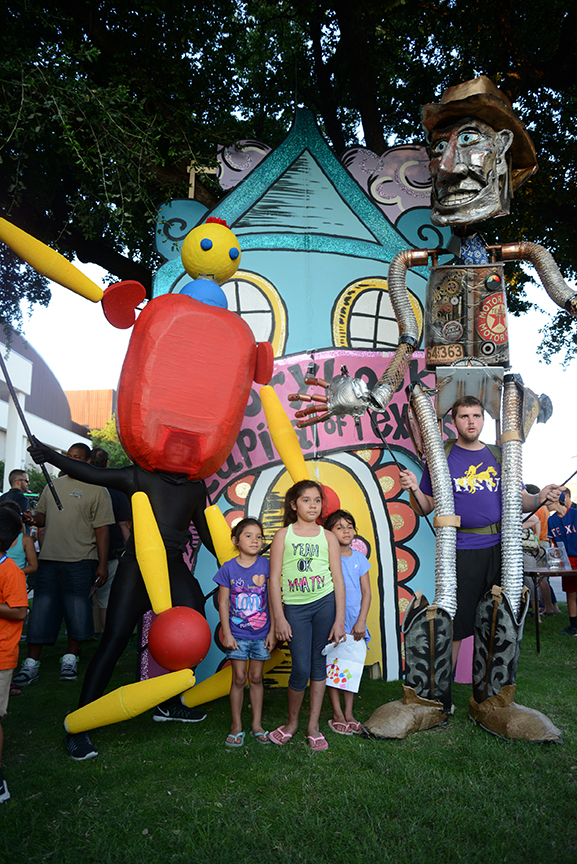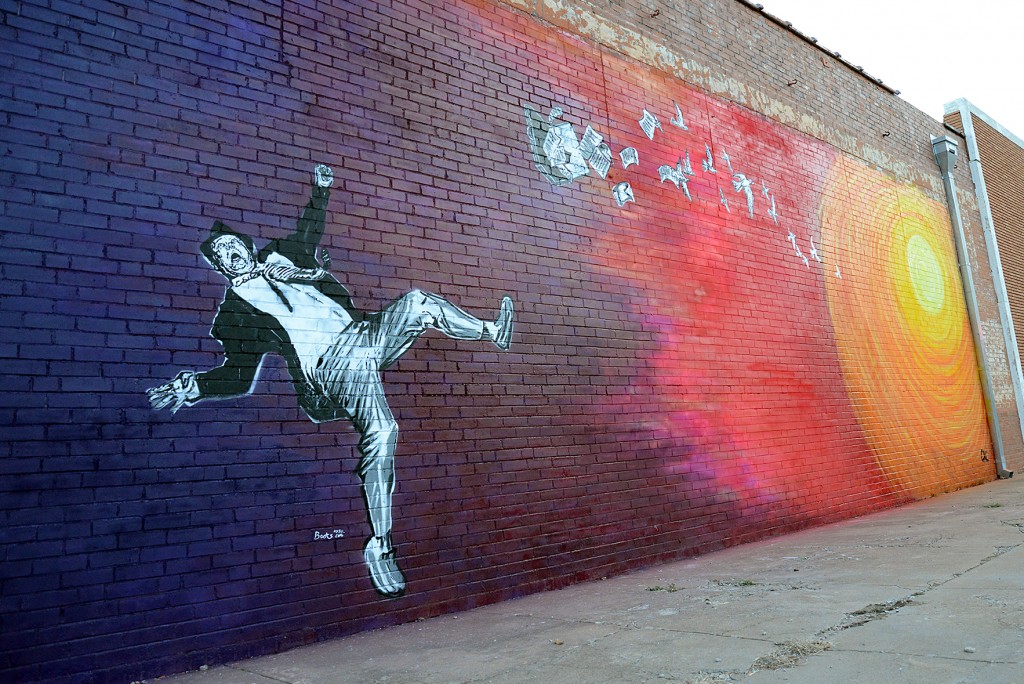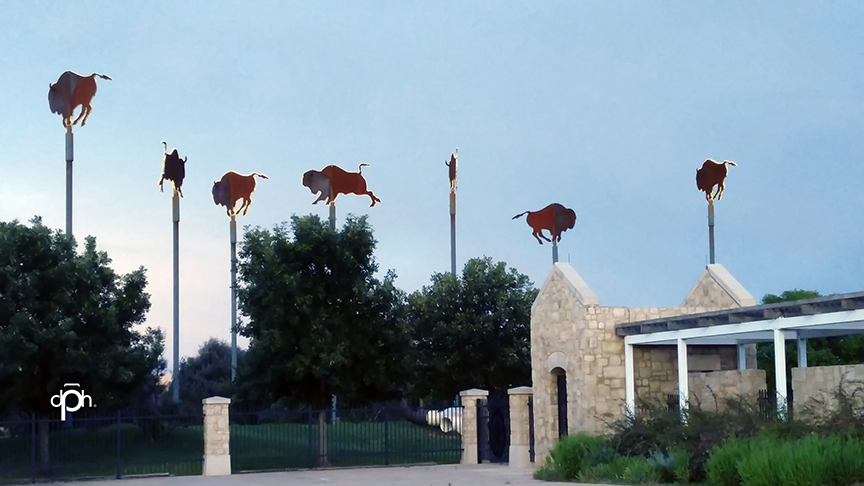Abilene’s Style
By Loretta Fulton
Photography by Doug Hodel
The Big Apple. The Big Easy. Every city has its own style. Las Vegas has its glitz, Los Angeles has its freeways, New Orleans has its Big Easy jazz scene, and New York, the Big Apple, has it all.
What is Abilene’s style? What do people think when they hear the name, “Abilene”? Do they envision the Old West? Probably. But after just one visit, they’re likely to add a couple more descriptors to Abilene’s style: historic preservation and culture.
Children’s author and illustrator William Joyce had never actually been to the city when he set his “Santa Calls” storybook in Abilene. He picked it out of every other name on the map because “it sounded cool” and fit the Western narrative of the tale.
He was blown away his first trip here, at the invitation of Gary McCaleb, who was mayor when the book came out. Joyce wrote in one of his books of being amazed that the city where he set his Christmas story was building a National Center for Children’s Illustrated Literature, and it all started with his storybook and McCaleb’s vision.
“It just went from there,” McCaleb said.
Did it ever. McCaleb first learned of the “Santa Calls” book and its setting in Abilene in 1993. McCaleb, as mayor, routinely read books to children in elementary schools. One day, a teacher handed him a new Christmas book, “Santa Calls.” As McCaleb began to read, he was stunned. Santa’s first stop in the book is Abilene, Texas.
“Right there in the first paragraph,” McCaleb said, still amazed.
Being the visionary and man of action that he is, McCaleb set things in motion that led to installation of a sculpture depicting a scene from “Santa Calls” and opening of the NCCIL in September 2000.
Today, the NCCIL, as it’s known locally, epitomizes three distinct styles that characterize Abilene —historic preservation, Western identity, and culture. The NCCIL got its start based on Abilene’s Western identity, is located in a renovated historic building downtown and showcases art and culture.
Abilene’s three distinctive styles are regularly promoted through local events and organizations like the Abilene Preservation League, Western Heritage Classic, and the Abilene Cultural Affairs Council.
Thanks to the NCCIL, the Abilene Cultural Affairs Council and other promoters, the Texas Legislature anointed Abilene as the “Storybook Capital of Texas.” A major annual celebration of the storybook capital is the Children’s Art and Literature festival, appropriately known by its Western-sounding acronym, CALF.
In five years, CALF attendance has more than doubled, from 2,000 in 2012, its inaugural year, to 4,300 in 2016. Visitors this year came from 93 Texas cities and eight states.
“We’re gratified the word is getting out,” said Lynn Barnett, executive director of the Abilene Cultural Affairs Council.
An emphasis on art also is celebrated downtown with the monthly ArtWalk hosted by the Center for Contemporary Arts. The Abilene Philharmonic office, Abilene Ballet Theatre, and Abilene Performing Arts Company all are highly visible downtown. The railroad right-of-way that stretches across town is lined with outdoor sculptures. Buildings downtown and nearby are graced with colorful, artistic murals.
Barnett has ceased being surprised to hear visitors praise Abilene’s restored downtown, its Western flavor and its emphasis on art.
“People are always surprised at how beautiful our downtown is,” Barnett said. “It’s just amazing we have these beautifully restored buildings.”
Chief among them are the NCCIL, located in the renovated Rhodes automotive shop, The Grace Museum, the Paramount Theater, the Elks Building that houses the preservation league, and three buildings along the railroad, including the depot where the Cultural Affairs Council and Abilene Convention and Visitors Bureau are located.
In the middle of all that is Everman Park, a tribute to downtown revitalization and home of numerous storybook character sculptures. Currently, the downtown boasts 18 sculptures. Another 15 will be added next summer in a new sculpture garden being created at the Civic Center.
Abilene’s three style elements—historic preservation, Western identify, and culture—are at the heart of promotions designed to bring conventions and other gatherings to Abilene. “Bring out the West in you” is a slogan aimed at visiting groups that might consider a historic venue as a meeting place.
In September, the Abilene Convention and Visitors Bureau, headed by executive director Nanci Liles,
Is hosting a regional workshop for people involved in the hospitality industry. Part of the meeting will be devoted to a cultural and historic sites tour.
Liles said the bureau capitalizes on Abilene’s Western heritage and its cultural scene in its promotions.
“Spend a few days scouting this legendary area—a place where Western heritage is both a birthright and a pastime,” reads one promotion.
Recently, Myra Dean, a member of the ACVB board, was walking out of the Grace Museum when she noticed a couple who looked lost. They were from Arlington and wanted to know what there is to do in downtown Abilene.
“That was like opening a big door,” Dean said.
Before she was done listing everything downtown has to offer, the couple was stunned. Dean wasn’t surprised. She has toured with visiting groups many times. Dean is a graduate of Leadership Texas, which holds meetings in various Texas cities. One year, the group met in Abilene before heading to Dallas and Houston.
When the group left Abilene, the people in charge of the Dallas and Houston tours were petrified.
“Oh my gosh,” they said, “I don’t know how we’ll ever match what Abilene has done.”
Part of Abilene’s Western heritage includes hospitality. Abilene is known as a friendly, welcoming community, and that isn’t lost on visitors who constantly praise the hospitable atmosphere.
“It’s a recurring theme,” Dean said.
Perhaps no better examples of Western heritage and hospitality exist than at Frontier Texas and the annual Western Heritage Classic. Frontier Texas in an interactive museum, featuring spirit guides speaking to visitors through hologram technology. But it is much more than that. Although not housed in a historic building, it replicates Fort Phantom, Abilene’s first military installation. And, it tells the history of West Central Texas through the interactive museum and art.
The brainchild of H.C. Zachry, Frontier Texas combines Abilene’s Western heritage and cultural emphasis in a stunning way. Zachry’s exquisite murals help tell the story of the settling of this area of the state.
Sculptures of a buffalo outside and a cattle drive inside, both by T.D. Kelsey, capture in dramatic style the essence of the Old West. Eight flying buffalo, another of Zachry’s ideas, brought to fruition by Rentech boilers, add a layer of art and whimsy to the endeavor. Reviews on TripAdvisor rave about the experience.
“One of the best museums I’ve ever seen in my life,” one visitor said. “Well structured, very interesting. Lot of stuff to see and to learn about Texas, Frontier and Wild West.”
Frontier Texas doesn’t just impress out-of-town visitors. It actually was transformative for Abilenians, said Jeff Salmon, executive director. Seeing how visitors responded to Abilene’s Western heritage made locals change their own views.
“I believe that after we opened Frontier Texas,” Salmon said, “people became much more comfortable with the word ‘frontier.’”
If it’s authentic Texas people want, they can join the thousands of other visitors to the Western Heritage Classic, held each May since 1985 at the Taylor County Expo Center. The classic features a ranch rodeo with authentic everyday cowboy skills on display, a chuck wagon cookoff, ranch horse sale and a new “horse whisperer” demonstration and competition.
This year, 29,708 visitors came to the event, said Rochelle Johnson, executive vice president and general manager of the Expo Center.
“I felt like this year was the best year we’ve had,” she said. “People are fascinated by it and awestruck by it.”
Besides the Western Heritage Classic, the Expo Center hosts numerous equine events year-round, all with a Western flavor. Cutting horse competitions, rodeos, roping contests abound. The annual 4-H Horse Show and Texas High School Rodeo Association State Finals are held in Abilene—where else?
Much of Abilene’s historic look is due to restoration architect Rick Weatherl. When he drives around the city, he sees things a little differently from most. He sees the city’s style changes reflected in its architecture.
Abilene was founded in 1881 as a railroad town on the Texas and Pacific line. As tents and wood frame buildings started being replaced by permanent structures, the city gained a new look and a new style, which is reflected today in restored buildings, particularly downtown.
The Grace Museum, with its dark brick, is a prime example. The railroad brought the bricks that were used in its construction.
“You were importing a look,” Weatherl said, “kind of a mission style.”
In the late 1920s, lighter brick came into vogue, with numerous examples all over town.
“The city just changed looks,” Weatherl said.
Hardin-Simmons University, the oldest of the city’s three four-year universities, features buildings made of dark brick. The two younger universities, Abilene Christian and McMurry, consist of buildings made of light-colored brick.
Buildings constructed toward the middle of the 20th century, like the public library and the old Bootery shoe store, were excellent examples of the international style favored in that era, Weatherl said.
Those diverse styles are well represented in Abilene, but it’s the historic look that most people envision when they hear the word “Abilene.”
“Our image is Western to people all over the world,” said Bill Minter, executive director of the Abilene Preservation League.
But something was different about Abilene from the start, Minter said. Quality and artistic design were emphasized, as evidenced by the historic downtown buildings that have been restored.
“Somehow,” Minter said, “we distinguished ourselves.”
Today, thousands of visitors who come to the city each year are grateful for that distinction. Aided by its Western name, Abilene is a destination for tourists looking for historic preservation, Western heritage and a cultural experience.
That comment from a visitor here for a convention most likely is repeated often as people leave for another destination after visiting Abilene: “I don’t know how we’re ever going to beat this.”



































Leave a Reply